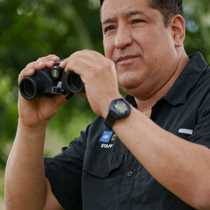Amazon Natural Park & Nauta Caño
I woke up today in high spirits wishing to have a great day, and we had it! This day of exploration of the Peruvian Amazon took us to a recently created private reserve, which is found outside the boundaries of the Pacaya-Samiria Reserve. The Amazon Natural Park, protects a very vast area of native “terra firme” forest where very old and famous Amazon trees can be found. This private reserve is so well managed and patrolled that the Government of Peru recognized its conservation value and declared it a national private protected area of the country in June last year.
To explore this location we completed a circuit that included several activities. We started by rowing peacefully aboard three wooden catamarans in a paradisiacal quiet lagoon. After that we disembarked on a rustic little dock. Once inside the forest we were immediately and gratefully impressed by the beauty of a primary forest where its flora is still practically untouched. While walking in the forest we admired some huge ficus and rubber trees found on the trails. We observed many lianas, vines, and flowers as well. A remarkable sighting was a poison dart frog (Ameerega hahneli). This is one of the most beautiful and spectacularly colored frog species found in the Upper Amazon. Poison dart frogs are of the most eagerly sought by visitors for they are not only beautiful but have a remarkable natural history as well. These frogs have alkaloid skin secretions that give them their common name. Traditionally many indigenous people use these powerful toxins all over the Amazon region to coat hunting darts and arrows. The toxicity of the secretions is determined by the frogs´ diet that consists mainly on some species of ants that they prefer to eat. The chosen ants contain high concentrations of formic acid. In captive conditions when these frogs are fed with other kind of insects they lose the toxicity.
The trail leads to a very long suspension bridge, which is approximately half a mile in length. This infrastructure allowed us to have a thrilling and exciting walk in the middle strata of the rain forest. We were above the ground watching the rain forest from a completely different perspective. It felt, in some ways, how some of the inhabitants of the rain forest see the world—a dimension that is completely new for us. After crossing the bridge we headed back to the catamarans to row back to the place where we disembarked in the early morning.
Once aboard, refreshed with a well-deserved shower and drinks we had a succulent and delicious lunch. In the early afternoon we had a very amusing and interesting presentation. Luis Vela, one of our young but experienced Delfin II naturalists, had an exhibition on the Peruvian Upper Amazon fruits. Colors, textures, and new flavors were tried by our visitors provoking admiration and delight to all their senses.
The late afternoon was spent exploring Nauta Caño and its surrounding. We truly enjoyed this outing. As the narrow stream is almost closed due to the low waters of the season we spent most of our time in the surroundings of the creek. In the thick vegetation of the area our naturalists spotted several species of colorful birds like macaws and toucans as well as a couple of brown three-toed sloths.
Before dinner our naturalists told us about their backgrounds in an informal, yet informative introduction of their lives. Finally, late in the evening, we went to bed with many unforgettable feelings and memories in our hearts and minds of this full day of exploration in the Peruvian Amazon aboard the Delfin II.




